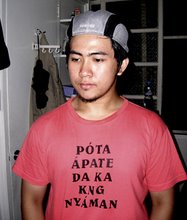FROM THE NEWSROOM
By FRANCIS S. LAGNITON
Some say it’s very challenging to have "one Philippines" because Filipinos speak more than 170 languages and dialects. Those with the most number of speakers are Tagalog, Ilocano, Cebuano or Sugbuhanon, Hiligaynon or Ilonggo, Bicolano, Waray, Maguindanao and Maranao.
In the 1930s, Commonwealth President Manuel Luis Quezon sought to legislate a national language, called Pilipino, based on his native Tagalog. But as late as the 1970s and even in cities in the Visayas and Mindanao, people refused to use the lingua franca of imperial Manila and wanted the national language to be based on their own native tongues.
Despite the opposition, there is an evident increase in the use of Filipino. The credit belongs to Manila-based broadcast networks that, after the collapse of the Marcos dictatorship in 1986, started to regularly beam Tagalog soap operas and comedy shows across the nation via satellite. Radio programs followed shortly thereafter.
But there is also a price to pay for the growth of the national language. There is now a decline in the use of some languages, like Capampangan and Pangasinan, and this has resulted in the loss of literature and the diminution of the richness and history of a culture that reflect the age-old values of a free people.
When Quezon launched the bid to create a national language, based on Tagalog, he undoubtedly thought it was an essential tool in uniting an archipelagic nation further divided by many dialects. But whatever gains we have had in forging national unity through one national language, we have also lost much in cultural diversity.
The Pangasinan language, or Pangalatok, is in real trouble. Even in the cities of Pangasinan, Pilipino is now the language spoken in many homes. Besides this decline in the spoken language, there is also a dearth in Pangasinan literature and even Pangasinan folk songs are no longer heard, even in rare cultural presentations.
Much of the same is true for Capampangan although it continues to be widely used in Pampanga and Tarlac. There is also a dearth of Capampangan literature, save for a few not-so-very-good examples on Internet websites.
The problem has become so evident that the city council of the city of San Fernando has seen fit to integrate the Capampangan language city schools and the Pampanga provincial council is supposedly set to do the same. This is a simple but vital step in areas where the native language is in danger. Perhaps it would also help if some civic group sponsors a literary competition that may produce another Juan Crisostomo Soto.
Alben meng manyaman, boy!
March 6, 2008
National unity vs cultural diversity
Amanung susi:
Cross-Ethnic,
Current Events,
Issues,
Language,
Media,
Personalities
Subscribe to:
Post Comments (Atom)







1 comment:
sir ayus ya ining blog mu ah.. habang babasan ke ini, aicip ku mu.. ot ali tamu mgorganize capampangan stand up comedy competition okaya kunan taya tema itang "Yo Momma" ning MTV.. tutal kilala tana man bilang mapanisti.. hehehe.. instead of inda ya ing pisasabyan.. gawan tayang "style ning pamagluto".. atandanan ke kc i tatang ku kanita anyang megluto yang "lutong toyu" i wali ku.. tekman na tsaka na sinabi "aydo nyaman.. lalasang embalsamo!!" eku mu balu nung feasible ya kareng tau keni.. hehehe.. atleast masaya ya ita tsaka tana mu mantun tutuking crisot.. hehehe
Post a Comment